Site menu:

October 2013 Newsletter
Knots on the Dee Estuary 2012/13.
Wirral's Wonderful Waders.
Wanted - Voluntary Wardens at Point of Ayr.
September Bird News.
Forthcoming Events.
Latest Newsletter.
Knots on the Dee Estuary 2012/13
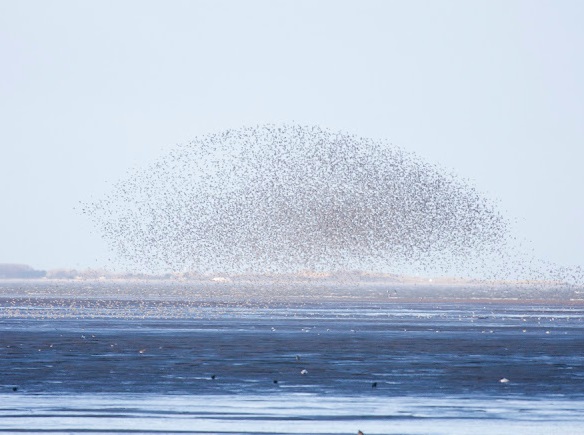
see fromthemuddybanksofthedee.com
A large flock of Knot, perhaps 20,000 strong, must surely impress
anyone who sees this spectacular sight - even complete non-birders or,
at the other end of the scale, hard core twitchers who will
claim they are only looking at them in
case
there is a Great Knot in the flock! There were certainly plenty of
opportunities to see large numbers of Knot last winter here on
the Dee Estuary, which was the best winter for this species
for many years.

The graph above gives you an idea of the size of the flocks we saw. Dawpool Bank is the huge area of mud bank off Thurstaston Shore and it was just carpeted with Knots on Jan 9th when I counted 48,000 there. I only know of one higher single site count on the estuary since 1970, that was 52,000 at Hoylake in December 2001. Unfortunately, I only received one count from the Point of Ayr, but it was a big one with 42,500 on Dec 16th. The counts at West Kirby was of birds actually on the ground at the roost, whereas most of those from Hilbre were of flocks flying over, either flying out of the estuary or heading towards the high tide roost at Hoylake. For the forthcoming 2012 Cheshire and Wirral Bird Report CAWOS have received no less than 93 Internationally Important counts from the English side of the Dee Estuary, of which 32 were 20,000 or greater, compared to 43 Internationally Important counts in 2011 of which only two were 20,000 or greater.
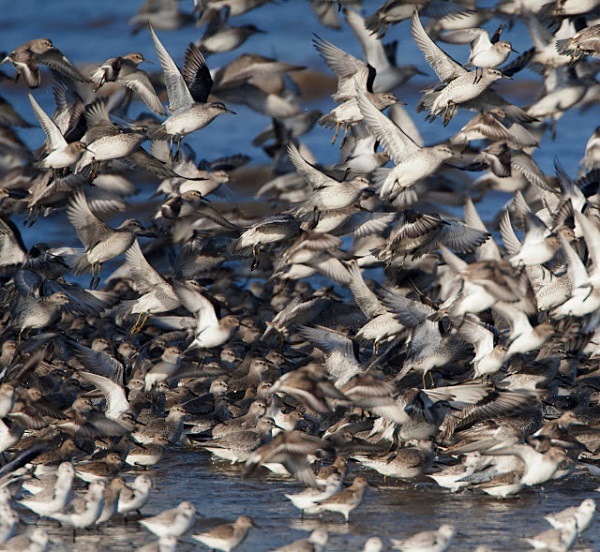
see fromthemuddybanksofthedee.com
But never mind about all these facts and figures - it was the spectacle of those tens of thousands of birds which really stick in the memory, particularly during the January spring tides at Hoylake. Saturday January 12th was the day of the High Tide Birdwatch and it was an outstanding day with at least 200 birders enjoying the spectacle of 25,000 waders, mostly Knot, pushed in by a big high tide. If Saturday was outstanding then Sunday was even better with the higher tide pushing the birds that much closer, for about 30 minutes half the Knot flock aerial roosted overhead which was an amazing sight in itself with constant movement and turnover of the birds. Then came Monday which was simply astonishing, the birds were so close to the end of King's Gap you could almost touch them, unlike the previous day the birds stayed mainly on the sand and were surging backwards and forwards like breaking waves. I'd never seen anything quite like it before!

To put last winter in perspective I have to show one more graph, below. It shows the Wetland Bird Survey (WeBS) counts from when the scheme started in 1970 to the present day. The 1970s saw counts consistently around the 40,000 mark, this was followed by a sharp fall in numbers in the 1980s which was due to increased disturbance on the estuary. Since the winter of 1989/90 max counts have fluctuated wildly, the best example of this being a peak count of 5,672 in the winter of 2000/01 followed by the highest ever WeBS count, 52,692 in 2001/02. The max WeBS count this last winter of 50,266 is therefore the second highest on record. In contrast to all this the counts for the whole country have been pretty steady for the whole period. I have written several articles discussing Knots on the Dee Estuary and their fluctuations in number over the years, so if you want to find out more look at the Newsletter articles mentioned below.
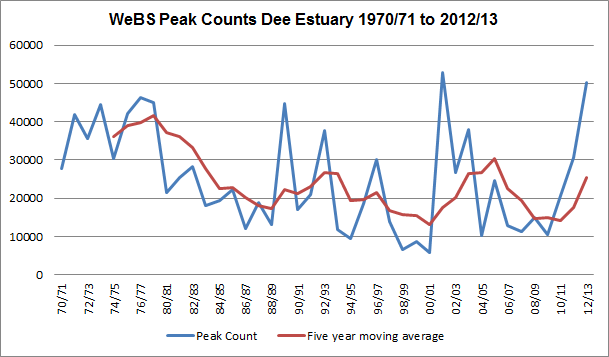
Richard Smith
Sources of Information for this article and further reading:
1. www.deeestuary.co.uk
- bird sightings archive.
2. Cheshire and Wirral Bird Reports: 1970 to 2011.
3. Cheshire and Wirral Bird Report 2012, in preparation.
4. Neil Friswell and Colin Wells, Dee Estuary and North Wirral
Foreshore WeBS Annual Report, 2011/12.
5. Chas Holt et al.
, Waterbirds in the UK 2010/11 (WeBS).
6. Richard Smith, North-west Estuaries Part 2 - Knot and Dunlin, July
2010 Newsletter.
7. Richard Smith, WeBS and Waders, May
2007 Newsletter.
8. Richard Smith, West Kirby High Tide Wader Roost, July
2005 Newsletter.
9. Richard Smith, The Knot,
April 2000 Newsletter.
10. J.R. Mitchell, M.E. Moser and J.S. Kirby, Declines in midwinter
counts of waders roosting on the Dee Estuary, Bird Study (1988) 35,
191-198.
11. J.S. Kirby, C. Clee and V. Seagar, Impact and extent of
recreational disturbance to wader roosts on the Dee Estuary: some
preliminary results, Wader Study Group Bulletin, 68: 53-58, 1993.
WeBS (Wetland Bird Survey) data in this article should not be used elsewhere in any way without permission of the WeBS Office. To access official WeBS data please contact the WeBS Secretariat - BTO, The Nunnery, Thetford, Norfolk IP 24 2 PU www.bto.org.
Wirral's Wonderful Waders
The Dee Estuary Voluntary Wardens (see the Wardens Page) have produced a leaflet promoting the Waders of Wirral and also the work of the Wardens without which the High Tide roost at West Kirby would probably be just a distant memory. We are always on the look out for new Wardens so please help if you can. Full details are in the leaflet.
To download the leaflet please click on the links below, it is in two parts (PDF format).
Wirral's Wonderful Waders - PAGE 1 and PAGE 2.

Top of Page
Point of Ayr RSPB Reserve - Voluntary Wardens Wanted!
Point of Ayr, on the North Wales coast at Talacre, is a great place to watch a variety of birds as they come in to roost at high tide, but unfortunately the site is extremely vulnerable to human disturbance. The RSPB is looking for extra volunteers to help warden this invaluable roost site, and protect the birds throughout the cold winter months.
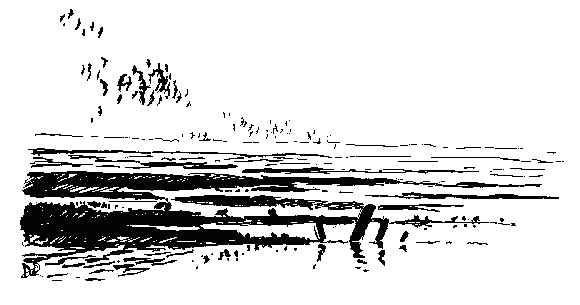
Shifts are run most weekends and typically last between 3-4 hours,
depending on the height of the tide.
If you would like to help in any way please contact the RSPB on 0151
353 8478 or Mobile 07860169452 . Not only
are you helping to save the planet, but it’s also great birdwatching
too!
Top of Page
September Bird News
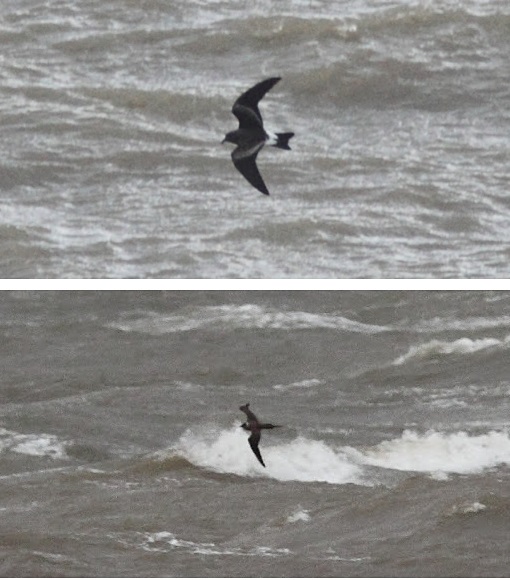
Top - Leach's Petrel on Sep 16th, Bottom - Adult Long-tailed Skua on Sep 17th.
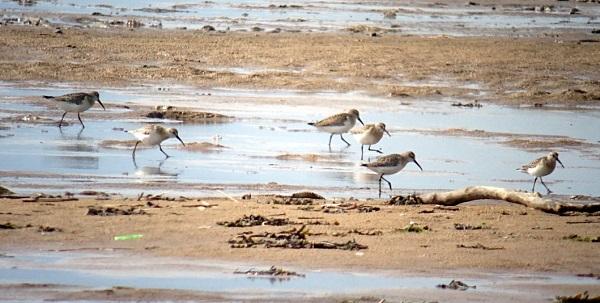
It was the second best passage of Curlew Sandpipers over the past 12 years, with numbers not quite reaching 2011 levels, as you see from the graphs below. It is interesting comparing the two years with both showing a distinct double peak. Also, in both years the early peak was of birds mainly along north Wirral, particularly Hoylake, whereas by the second peak most birds were further up the estuary at Burton Mere Wetlands and Connah's Quay.
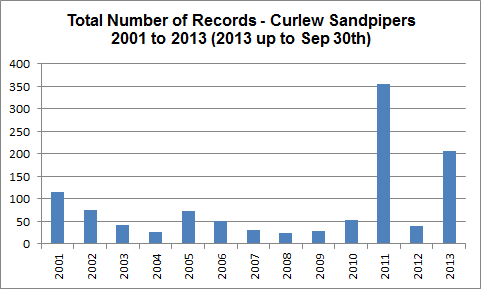
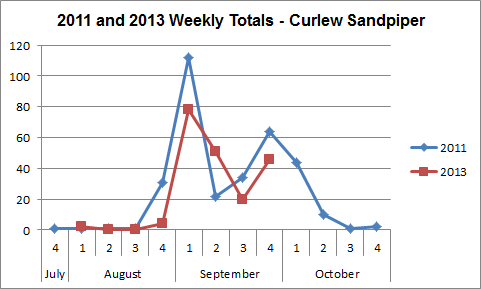
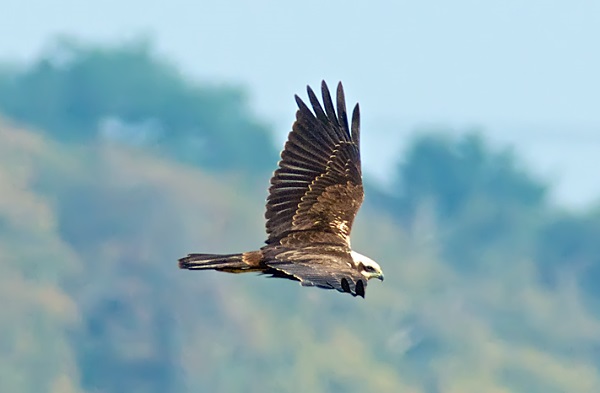
Although not as numerous as last year there were reports of one or two Marsh Harriers throughout the month, max three at Burton Mere Wetlands on the 8th. A ringtail Hen Harrier was also recorded several times on the marshes. Up to two Hobbies gave some great views at both Burton Mere Wetlands and the Inner Marsh Farm hide.
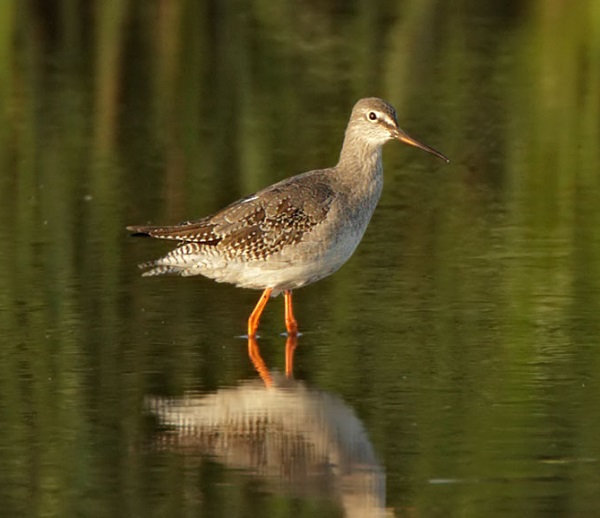
see Steve Round Photography.
Several days of east winds towards the end of the month eventually brought rich pickings with two Yellow-browed Warblers (Burton Marsh and Red Rocks) and a Blyth's Reed Warbler at Red Rocks.
Richard Smith.
What to expect in October
It was good for Curlew Sandpipers last month and the usual pattern during a good influx is a second wave of then to come through in early October. This month is usually good for rarities, last year alone we had Long-billed Dowitcher, Temminck's Stint, Spotted Crake, Red-throated Pipit and three Common Cranes.
One of the highlights this month is Visible Migration - given the right weather conditions and the right time and location this can be spectacular. One early morning last year we had 47,250 Starlings, 3,940 Chaffinches and 73 Bramblings over Red Rocks. To read more about 'Vis Mis' read the October 2010 Newsletter.
There will definitely be signs of the returning winter with a build up of both Brent and Pink-footed Geese, a return of the first Whooper Swans, several Short-eared Owls on the marshes and we should see a Snow bunting or two.
As I write this at the end of September we have had several days of east and south easterly winds with more forecast, this means there must be a very good chance of some good rarities turning up this month blown westwards during their return migration.
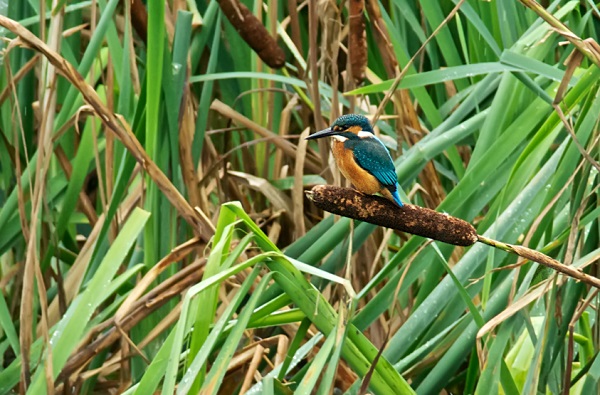
Top of Page
Forthcoming Events
October Highest Spring Tides (Liverpool)
Also
see Tides
page.
6th October, 12.34hrs (BST), 9.5m.
7th October, 13.11hrs (BST), 9.6m.
8th October, 13.50hrs (BST), 9.5m.
Forthcoming Events
Organised by the Wirral
Ranger Service , Flintshire Countryside Service and/or the
RSPB:
All these events and walks have bird interest, even those not
advertised specifically for birdwatching. No need to book for these
events unless specified - please check below.
Also see 2013 Events Diary.
High tide 9.4m at 11.59am.
An opportunity to visit this great reserve normally open to members only - should be large numbers of waders and duck roosting at high tide.
How to find us: From A548 take the Connah’s Quay turn off and follow the Power Station signs. At the reserve entrance, (Grid ref SJ271 714) you will be met by a member of the Society.
Tea and coffee available at the Field Studies Centre.
FREE ADMISSION
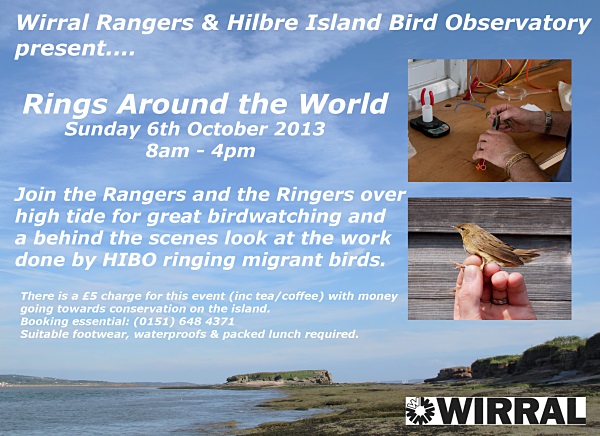
Saturday 19th October, 10:00am start, High Tide Birdwatch at Hoylake:
Join the Coastal Rangers, the Dee Estuary Voluntary Wardens and the RSPB to see the large numbers of wading birds on Hoylake beach. With a rising tide, we should see the birds at close quarters as they roost and feed. Beginners welcome. Dress warmly and bring binoculars if you have them.
Meet on the promenade at King's Gap, Hoylake. 9.4m tide just before noon.
For further information, contact the Coastal Rangers on 0151 648 4371.
Saturday 9th November 2013 from 11.00am to 4.00pm.
Cheshire and Wirral Ornithological Society 25th Anniversary Celebration 9th Nov 2013 CAWOS is pleased to announce that it will be holding a half day event to celebrate the 25th Anniversary of the Society on Saturday 9th November 2013 from 11.00am to 4.00pm.
Please come and join us for this, our Special Celebratory Day for members/ non members and friends, old and new at Leahurst Campus, School of Veterinary Science, Neston, CH64 7TE. The day will include a programme of talks about Cheshire's birds with associated quizzes and raffle. Lunch and refreshments included all for only £5.00pp.
For further information contact Clive Richards (tel. 01625 524527) or Ted Lock (tel. 01625 540466).
Application forms can be downloaded by clicking on this link.
Saturday 30th November 12:00 noon – 3:00pm
Take Tea on Hilbre with the RSPB
Walk across the sands to Hilbre Island where the RSPB will be serving tea and biscuits during the above date and time. They will be on hand to show you the island’s unique wildlife and will tell you about the work that the RSPB are doing at their fantastic reserve at Burton Mere Wetlands. There is no need to book, just turn up. Suitable clothing and footwear are essential for the walk out and please note – this is not a guided walk. Remember to bring money for the tea!
For further information, please telephone (0151) 648 4371.